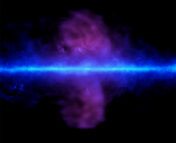Authors: Jacobson-Galán, Dessert, Jones et al.
First Author’s Institution: University of California, Berkeley
Status: Submitted to ApJ [open access]
Massive stars end their lives as energetic explosions known as core-collapse supernovae. However, some stars have their final words! In the months leading up to the explosion, stars can expel some of their outer layers causing their brightness to increase dramatically. Today’s paper describes a supernova (SN) that showed such “precursor emission” prior to the final supernova explosion.
SN 2020tlf – the star that spoke before it died
The supernova SN 2020tlf was discovered by the ATLAS survey on 16 September 2020 in the galaxy NGC 5731. The authors of today’s paper noticed that this galaxy had been observed by the Pan-STARRS telescope regularly since 18 January 2020. These observations were part of the Young Supernova Experiment (YSE). The authors examined the YSE data and voila! They found that there was significant activity at the location of SN 2020tlf for more than a hundred days prior to the explosion! Figure 1 shows this precursor activity of SN 2020tlf.

After this discovery, the authors obtained additional spectroscopic and photometric observations to identify the nature of the supernova. Their spectroscopic observations indicate that SN 2020tlf is a type IIp supernova. Type IIp supernovae are explosions of red supergiant stars (RSGs) and are characterized by a long plateau in their brightness lasting for a few months after explosion. Type IIp supernovae are pretty common in the universe – however precursor emission has not been detected for any type IIp supernovae in the past! SN 2020tlf is thus the first type IIp supernova that shows pre-explosion brightening. From the post explosion data, the authors calculate that the exploding star was a RSG with a mass of 10-12 M☉ and a radius of ~ 1,100 R☉ .
Precursor emission = signs of mass loss
The authors note that the pre-explosion activity is detected only in the redder photometric r, i and z-band observations, but is absent from the bluer g and cyan band observations. This suggests that the precursor emission is red, suggesting that it comes from a cold surface (recall blackbody physics – bluer is hotter and redder is colder!). The authors find that the precursor emission comes from a surface with a temperature of cool(!) 5000 K and a radius of 1014 cm (~1,000 times the radius of the sun). This is consistent with the expectation of a red supergiant star that is shedding its outer layers. From the precursor emission, the authors calculate the RSG was surrounded by at least 0.3 M☉ of dense circumstellar material (CSM) in its final days.
There are signs of this CSM in the post-explosion observations as well. A spectrum taken just a few days after the explosion shows several narrow emission lines of H, He and . Such a spectrum is characteristic of a large amount of circumstellar material (CSM) around the star. In addition, the early lightcurve shows signs that it is dominated by interaction of the supernova ejecta with this CSM. From the lightcurve and spectra to determine that the RSG was surrounded by 0.05-0.07 M☉ of CSM. This is smaller than the mass derived from the precursor emission. The authors are not able to resolve this discrepancy satisfactorily, but note that this could be resolved if the precursor emission mechanism was super-Eddington in nature.Regardless of the exact value of the CSM mass, the RSG was losing mass at a rate of 0.01 M☉/yr in the months prior to explosion. This is significantly larger than mass loss rates expected in normal stars (the Sun has a mass loss rate of 10-14 M☉/yr).
What caused the mass loss?
The leading theory for the enhanced mass loss is that it was triggered by some instability inside the star. One possibility is that the mass loss was driven by waves in the envelope of the star, caused by the pulsations in the core. Such mass loss is possible for stars of mass, M < 14 M☉. However, in this model, the mass loss is expected to last for significantly longer than the 130 days as observed for SN 2020tlf. A second model is that the mass loss was a result of some sudden energy deposition in the star’s envelope. If the deposited energy is equal to the binding energy of the star’s envelope, it can produce a detectable precursor emission that lasts for a few hundred days and has temperatures and luminosities roughly consistent with that of SN 2020tlf. This energy could be deposited by burning of oxygen and neon or silicon in the core of the star. However, additional studies are required to understand the exact reason for the precursor emission.
The authors note that such precursor emission should be fairly common in type IIp supernovae. However, as this emission is intrinsically faint, it is challenging to detect. Future, more sensitive surveys such as the Vera Rubin Observatory will be equipped to detect the final words of the stars.
Disclaimer: Today’s editor is in the same research group as first-author Jacobson-Galán but was not involved in this project. Jacobson-Galán is also an active Astrobites author but was not involved in the publication of today’s bite.
Astrobite edited by : Huei Sears
Featured image credit : NASA, ESA, and E. Wheatley (STScI)




